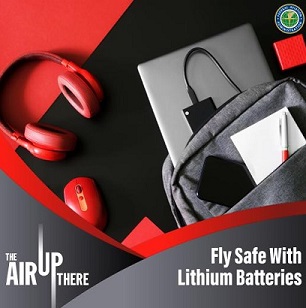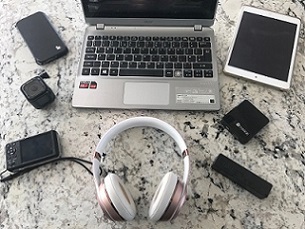 Federal Aviation Administration podcast on lithium battery safety
Federal Aviation Administration podcast on lithium battery safety
 A pilot holding an AvSax lithium battery fire mitigation bag
A pilot holding an AvSax lithium battery fire mitigation bag
 All these everyday electronic devices are powered by lithium batteries
All these everyday electronic devices are powered by lithium batteries
Airline passengers should NOT charge their phones or other electronic devices before taking them on aircraft.
The urgent warning comes from the organisation which oversees flight safety in the USA, the Federal Aviation Administration, and follows a spate of lithium battery fires in board aircraft.
The FAA has recorded 450 incidents in US airspace or on American aircraft since 2006 – 29 so far in 2023 – but there will be many more happening worldwide which go unrecorded.
The concern is that a fully charged lithium-ion battery carries a greater risk of thermal runaway which could spark a fire or even an explosion because a fully charged battery will have more energy stored in it.
The FAA has tweeted out the warning on social media, saying: “Before getting on an airplane do you charge your lithium powered devices to 100%? A full charge may increase the chances of a fire. If you won’t be using it on your flight why risk it? Learn to prepare your device for a safe flight at https://www.faa.gov/podcasts/the_air_up_there/fly-safe-lithium-batteries
The video says that if people have their devices 30% charged or below there is less chance of it going into thermal runaway.
It adds: “Another thing to do would be to not charge it, keep it powered off and not plugged in.”
Robert Ochs, Manager of the Fire Safety Branch at the FAA’s William J. Hughes Technical Center, says on the podcast: “Lithium batteries have a high energy density so there’s a lot of electrical power in a relatively small volume battery pack. They can, however, undergo a failure mode called thermal runaway. This occurs if there is an internal short circuit within the battery itself where energy will start to flow within the battery and that creates a good amount of heat.
“If that heat can’t be dissipated then the heat just keeps building and building to the point where the cell fails and you can have everything from fires to explosions and it’s a very, very dangerous situation.
“Heat dissipation really is just the transfer of heat from the battery to its surroundings, its environment, something next to it. So, if the battery doesn’t have a way or a place to transfer that heat to that heat just stays within the cell and keeps getting hotter and hotter. So that’s why we recommend using water as a method to cool the battery. That water is a great heat transfer medium, it allows for heat to transfer quickly from the cell to the water.”
Thousands of aircraft carry AvSax lithium battery fire mitigation bags – the world’s best-selling ‘burnbag’ by far and the only one that uses water during the process to cool overheating batteries.
AvSax, devised and made by Environmental Defence Systems based in Huddersfield, Yorkshire, UK, are now on more than 16,750 aircraft operated by over 100 airline companies worldwide.
They have been used 33 times to deal with emergencies since the start of 2017 and every time they have been deployed the aircraft has been able to complete its journey safely with no need to divert or make an emergency landing.
AvSax, which won the Queen’s Award for Enterprise for its pioneering innovation – the highest award any business can get - is made from military grade material so can withstand the force of a blast if the device does explode.
This use of liquid in the cooling process is recommended by the Civil Aviation Authority in the UK and many other fire containment bags don’t work this way.
In its guidance the CAA states: “Since the development of the International Civil Aviation Organization (ICAO) guidance on dealing with an in-flight battery fire, new products designed for use in response to lithium battery thermal runaway events have become available.
“Products which provide both a cooling and containment capability are typically more aligned to the existing ICAO guidance as when used they are filled with water or other non-flammable liquid to act as a cooling agent.
“After knocking down flames it could conceivably take just a couple of seconds for a personal electronic device to be placed inside a containment bag, allowing it to be moved to a place of safety. Passengers could then return to their seats, mitigating potential unrelated safety hazards such as injury in the case of severe turbulence. Equally, the effect on flight crew in carrying out their duties following an event on the flight deck would be minimised.”
For more on AvSax go to www.avsax.co.uk